calsfoundation@cals.org
Jerome (Drew County)
| Latitude and Longitude: | 33°23’58″N 091°28’12″W |
| Elevation: | 131 feet |
| Area: | 0.10 square miles (2020 Census) |
| Population: | 24 (2020 Census) |
| Incorporation Date: | April 22, 1965 |
Historical Population as per the U.S. Census:
|
1810 |
1820 |
1830 |
1840 |
1850 |
1860 |
1870 |
1880 |
1890 |
1900 |
|
– |
– |
– |
– |
– |
– |
– |
– |
– |
– |
|
1910 |
1920 |
1930 |
1940 |
1950 |
1960 |
1970 |
1980 |
1990 |
2000 |
|
– |
391 |
97 |
112 |
82 |
76 |
76 |
54 |
47 |
46 |
|
2010 |
2020 |
|
|
|
|
|
|
|
|
|
39 |
24 |
|
|
|
|
|
|
|
|
The town of Jerome is located in southeastern Drew County, although its residents are more tied to Dermott (Chicot County) than to any city in Drew County. The location of a Japanese American relocation camp during World War II, the town of Jerome has been a transportation crossroads for most of its history.
Jerome is located near Bayou Bartholomew, which was the main route used by travelers during the territorial time of Arkansas. In 1835, Moses Upshard Payne of New Orleans, Louisiana, purchased several tracts of land near the bayou as an investment; some cotton was grown on the clearer patches of land, but much of the land was swampland filled with hardwood trees. The land was frequently rented or sold during the remaining years of the nineteenth century with little development taking place. In 1886, J. M. Waddell of New Orleans, along with at least two partners, acquired an interest in the land, and the group of investors conveyed a right-of-way for a railroad line to E. P. Reynolds & Company in 1890; the company was building a rail line for the Houston, Central Arkansas and Northern Railroad Company. (The rail line through Jerome would eventually become part of the Missouri Pacific system, which later was folded into the Union Pacific Railroad.) In 1900, interest in the land was acquired by the Chicot Lumber Company of Chicago, Illinois, which sold the same interest in 1905 to Aaron P. Bliss, who began the Bliss-Cook Oak Company at that time.
A sawmill town was established where the railroad tracks met the bayou; the town, first called Blissville, was incorporated in 1908. At that time, the town consisted of twenty-five men living on 260 acres. Herman Moeller, the secretary of the company, owned the sawmill in the town and began to refer to the company as the Jerome Hardwood Lumber Company, in honor of his son, Jerome Moeller. In 1919, Moeller officially incorporated the company under the name he had chosen, and the next year the town also reincorporated as Jerome, though its incorporation would later lapse.
During the 1920s, Jerome prospered. It had a movie theater, a pharmacy with a soda fountain, three doctor’s offices, hotels (including at least one hotel for African-American clients), and a school; the school consisted of several buildings, including a gymnasium, an auditorium, a cafeteria, and a home economics building. The sawmill burned in 1927 and was not replaced, but the planing mill continued to operate until about 1930. John Currie of Montrose (Ashley County) managed the general store until 1937. That year, the company sold the land and the buildings of Jerome to Sam Wilson of Montrose.
Two years later, Wilson sold this property to the U.S. government for $100,000. The government received 3,508 acres of land, all the houses in Jerome, a cotton gin, a general store, sixty-five mules, and three tractors. Under the guidance of the Farm Security Administration (FSA) and the National Youth Administration (NYA), Jerome became a resettlement colony, populated by thirty-six families who were moved from the Sunnyside Plantation Settlement near Lake Village (Chicot County).
A different group of Americans was resettled into the Jerome area after the United States entered World War II. Japanese-American citizens were removed from their homes in the western states of California, Oregon, and Washington and resettled inland based on fears that these Americans might cooperate with the government of Japan during the course of the war. Of the ten relocation camps built on government land, two were in Arkansas: one near Rohwer (Desha County) and the other near Jerome. The Jerome Relocation Center operated from October 6, 1942, to June 30, 1944; it was the last of the ten camps to open and the first to close. It was built by the A. J. Rife Construction Company of Dallas, Texas, at a cost of $4,703,347 and covered more than 10,000 acres between the Big and Crooked bayous near Jerome. The population of the camp reached 7,932 by January 1943 and eventually totaled 8,497. After the Japanese-American occupants were sent to other camps in June 1944, the same structures were used for German prisoners of war until the end of the war in 1945. Little remains of the camp, though a monument marks the location.
After the war, the government began selling the land it had acquired before the war, and the town of Jerome was purchased by John Baxter, who then sold the land to Charles Clifford Gibson Sr. Gibson and his son used the town as a headquarters for their extensive farming operations, running both the general store and the cotton gin. The Jerome School District was consolidated with that of Dermott in 1950, and the main school building was moved to Dermott, where it was used exclusively for Black students until the end of segregation. In 1954, the Alice-Sidney Dryer and Seed Company built a large drying plant along the railroad tracks in Jerome. The dryer has a storage capacity of 267,000 bushels of grain and can dry 2,000 bushels of grain an hour.
Incorporation of the town was allowed to lapse for some years, but the town of Jerome reincorporated in 1965. The remaining buildings of the school were added to the National Register of Historic Places in 2005 under the name Jerome Elementary School No. 22. In the twenty-first century, the dryer remains the principal structure in Jerome and the largest employer in the area.
For additional information:
Cofer, Brian. “Residents’ Sweat, Arm-Twisting Help Tiny Towns Survive.” Arkansas Democrat-Gazette, June 1, 1998, p. 1B.
DeArmond-Huskey, Rebecca. Bartholomew’s Song: A Bayou History. Bowie, MD: Heritage Books, 2001.
Gibson, C. C., III “Jerome, Arkansas: Some Personal Recollections and a Brief History.” Drew County Historical Journal 18 (2003): 24–33.
Steven Teske
Butler Center for Arkansas Studies
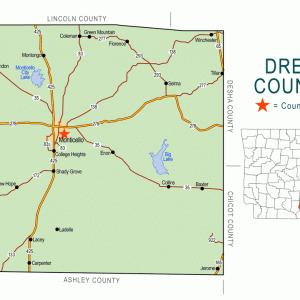 Drew County Map
Drew County Map 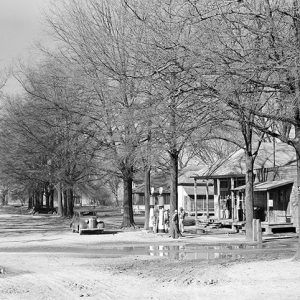 Jerome Street Scene
Jerome Street Scene 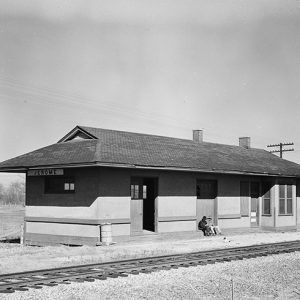 Jerome Depot
Jerome Depot  Jerome Cotton Gin
Jerome Cotton Gin 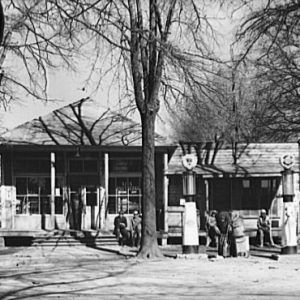 Jerome Post Office
Jerome Post Office 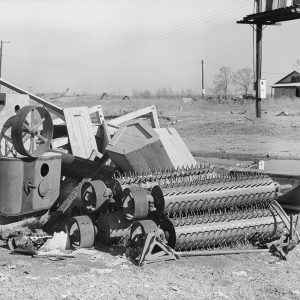 Jerome Cotton Gin
Jerome Cotton Gin 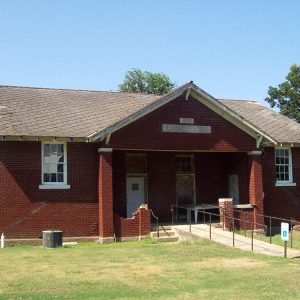 Jerome Elementary School No. 22
Jerome Elementary School No. 22 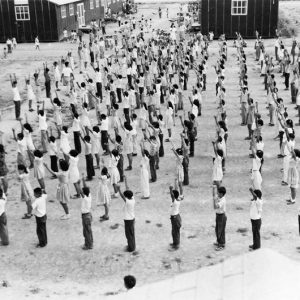 Jerome Relocation Center School Children
Jerome Relocation Center School Children 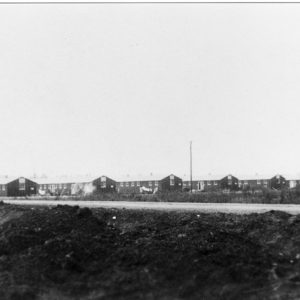 Jerome Relocation Center
Jerome Relocation Center 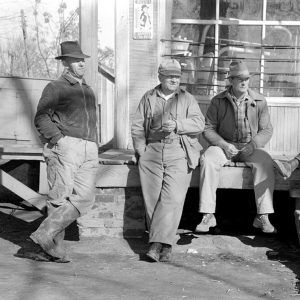 Jerome Street Scene
Jerome Street Scene 



Comments
No comments on this entry yet.